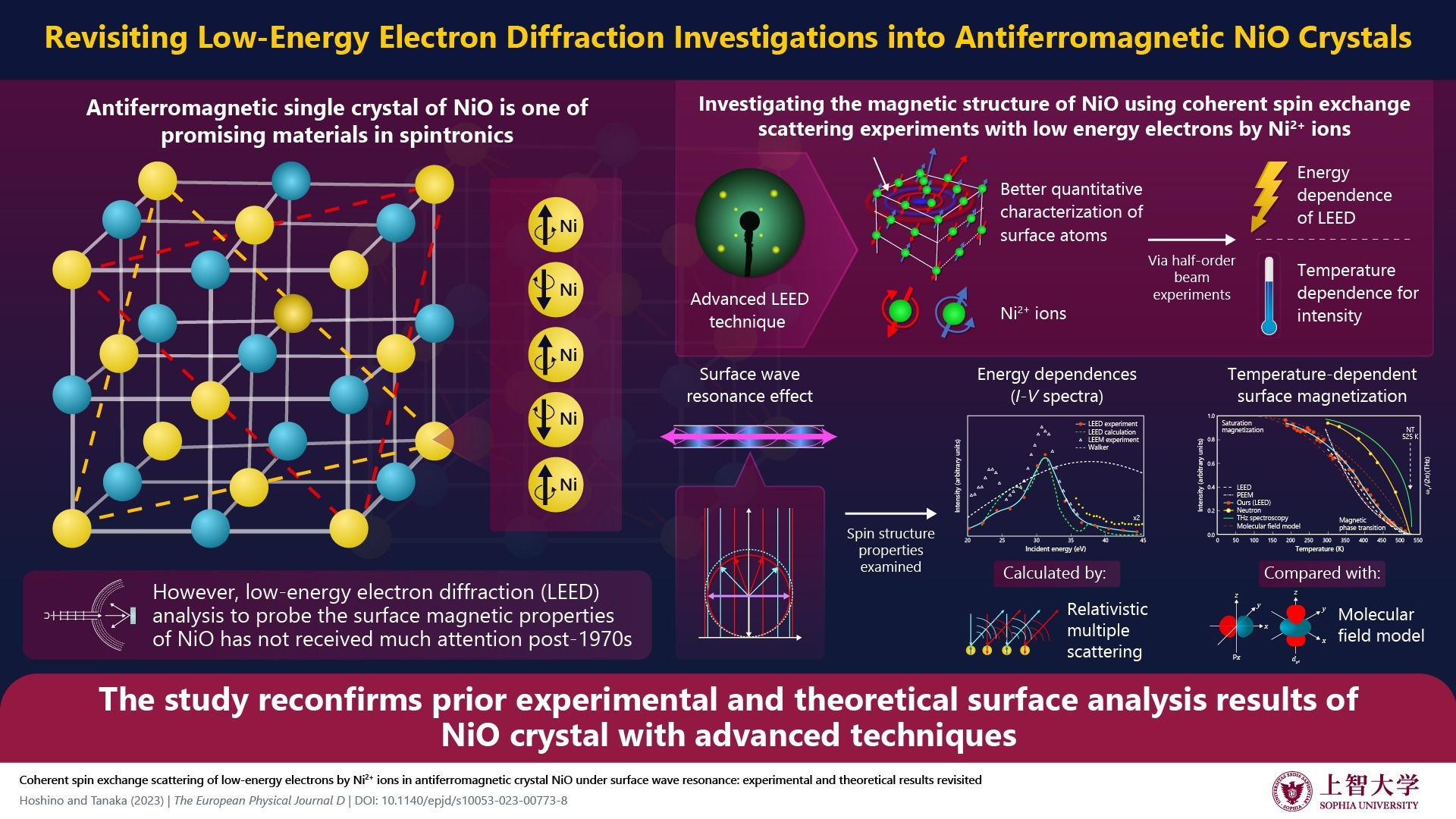Antiferromagnetic (AF) crystals like NiO are experiencing a renaissance as promising materials for ultrafast spintronics. To re-establish old experimental results of surface property investigations and present new theoretical analysis, researchers from Sophia University carried out low-energy electron diffraction (LEED) analysis of AF crystal NiO. They reported an I-V spectra of ‘half-order beam’ and observed a surface wave resonance effect, providing useful insights into energy-temperature dependence of LEED and coherent spin exchange scattering in NiO.
 Researchers carry out surface LEED crystallography of antiferromagnetic crystal NiO, providing experimental as well as theoretical insights for applications such as ultrafast spintronics. Image Credit: Masamitsu Hoshino and Hiroshi Tanaka from Sophia University
Researchers carry out surface LEED crystallography of antiferromagnetic crystal NiO, providing experimental as well as theoretical insights for applications such as ultrafast spintronics. Image Credit: Masamitsu Hoshino and Hiroshi Tanaka from Sophia University
Spintronics is a field that deals with electronics that exploit the intrinsic spin of electrons and their associated magnetic moment for applications such as quantum computing and memory storage devices. Owing to its spin and magnetism exhibited in its insulator-metal phase transition, the strongly correlated electron systems of nickel oxide (NiO) have been thoroughly explored for over eight decades. Interest in its unique antiferromagnetic (AF) and spin properties has seen a revival lately, since NiO is a potential material for ultrafast spintronics devices.
Despite this rise in popularity, exploration of its surface magnetic properties using low-energy electron diffraction (LEED) technique has not received much attention since the 1970s. To review the understanding of the surface properties, Professor Masamitsu Hoshino and Emeritus Professor Hiroshi Tanaka, both from the Department of Physics at Sophia University, Japan, revisited the surface LEED crystallography of NiO. The results of their quantitative experimental study investigating the coherent exchange scattering in Ni2+ ions in AF single crystal NiO were reported in The European Physical Journal D on 11th December 2023.
For the study, the researchers had two major objectives: to improve upon old experimental techniques used to decipher coherent spin exchange scattering of low-energy electrons by Ni2+ ions of NiO and to provide a reliable theoretical analysis using recent techniques.
They first carried out the quantitative characterization of surface atoms of NiO crystal using the LEED method. This allowed them to explore the energy dependence of LEED for “half-order beam” intensity via I-V spectra. Upon inspection of the I-V curve, the researchers observed a resonance enhancement which was attributed to the surface wave resonance (SWR) effect. This led the team to analyze the temperature dependence of LEED at the maximum intensity and surface spin properties under SWR conditions—a state where propagating diffracted beams emerge nearly parallel to the crystal surface.
For building a robust theoretical basis (to clarify the theoretical background), the researchers used (the more sophisticated) LEED dynamical theory to interpret the experimental results and revealed clearly the SWR as observed in the I-V curve. The temperature dependence measured over a wide temperature range enabled a more quantitative comparison with conventional molecular field theory.
This study not only succeeds in reaffirming previous experimental data on surface-spin structure and magnetic properties but also provides for the first time an I-V spectra of a half-order beam, the SWR conditions, and the temperature dependence over a wide temperature range.
“Unlike ferromagnetic materials that exhibit magnetism, AF materials, which do not exhibit magnetic properties as indicated by their spin arrangement, have been regarded as ‘unusable materials’. However, they are now being reborn. This phrase is often used now and the term, unusable materials was derived from Néel's Nobel Prize lecture (1970),” say the researchers when asked about the motivation behind revisiting NiO LEED experiments. “Furthermore, this research is at the cusp of a classic and new research theme that began in the 1970s through a personal communication from Nobel laureate Prof. N.F. Mott, known for breakthroughs in the research of Mott insulators such as NiO, as noted in the reference.” They further commented, “This research is specialized, focusing on academic and fundamental aspects, and is not intended for the public, but rather may help to elucidate the physical and chemical properties of promising antiferromagnetic materials.”